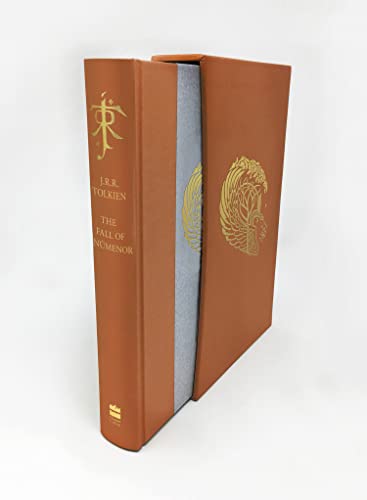Back
(edit info)
Tolkien: Maker of Middle-earth
by Catherine McIlwaine
9781851244850
Tolkien: Maker of Middle-earth is a 2018 art book exploring images of his artwork, illustrations, maps, letters and manuscripts of J. R. R. Tolkien. The book was written by Catherine McIlwaine, Tolkien archivist at the Bodleian Library. It was timed to coincide with an exhibition of the same name, also curated by McIlwaine.
The book documents Tolkien's creative processes behind his Middle-earth books with essays by Tolkien scholars and a catalogue of his artworks, each image accompanied by a descriptive and historical text. With some 300 illustrations, mainly in double-page spreads of image and text, the book draws on the collection at the Bodleian Library, Marquette University, and private collections. The book and exhibition have been widely admired by commentators.
The book is divided into two parts. The first part is a series of essays on key aspects of Tolkien's Middle-earth oeuvre. There is a brief biography of Tolkien by McIlwaine, and a chapter by John Garth on how the Inklings, a literary group that included C. S. Lewis, influenced Tolkien. Verlyn Flieger describes Tolkien's concept of faerie, referencing works such as On Fairy-Stories and Smith of Wootton Major as well as his Middle-earth books. Carl F. Hostetter introduces Tolkien's invented Elvish languages, Quenya and Sindarin. Tom Shippey comments on Tolkien's creative use of Norse mythology, and the northern ethos of courage without hope of victory, citing Beowulf and the Poetic Edda's Lay of Fafnir, to suit his own taste, faith, and knowledge of philology. Finally, Wayne Hammond and Christina Scull introduce Tolkien's visual art, arguing that his artwork was as thorough as his writing.
The second part is a catalogue of the exhibition, divided into chapters covering Tolkien's letters, his childhood, student days, inventiveness, his long effort on The Silmarillion myths, his work at home, The Hobbit, The Lord of the Rings, and his maps of Middle-earth. It provides some 300 illustrations, mainly in double-page spreads of image and text. Some are from the collection at the Bodleian Library; others are from the archive at Marquette University and from private collections.
The book documents Tolkien's creative processes behind his Middle-earth books with essays by Tolkien scholars and a catalogue of his artworks, each image accompanied by a descriptive and historical text. With some 300 illustrations, mainly in double-page spreads of image and text, the book draws on the collection at the Bodleian Library, Marquette University, and private collections. The book and exhibition have been widely admired by commentators.
The book is divided into two parts. The first part is a series of essays on key aspects of Tolkien's Middle-earth oeuvre. There is a brief biography of Tolkien by McIlwaine, and a chapter by John Garth on how the Inklings, a literary group that included C. S. Lewis, influenced Tolkien. Verlyn Flieger describes Tolkien's concept of faerie, referencing works such as On Fairy-Stories and Smith of Wootton Major as well as his Middle-earth books. Carl F. Hostetter introduces Tolkien's invented Elvish languages, Quenya and Sindarin. Tom Shippey comments on Tolkien's creative use of Norse mythology, and the northern ethos of courage without hope of victory, citing Beowulf and the Poetic Edda's Lay of Fafnir, to suit his own taste, faith, and knowledge of philology. Finally, Wayne Hammond and Christina Scull introduce Tolkien's visual art, arguing that his artwork was as thorough as his writing.
The second part is a catalogue of the exhibition, divided into chapters covering Tolkien's letters, his childhood, student days, inventiveness, his long effort on The Silmarillion myths, his work at home, The Hobbit, The Lord of the Rings, and his maps of Middle-earth. It provides some 300 illustrations, mainly in double-page spreads of image and text. Some are from the collection at the Bodleian Library; others are from the archive at Marquette University and from private collections.





 4366
4366 1.98M
1.98M